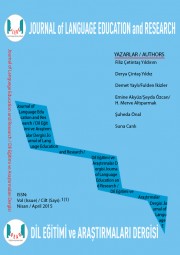Türkçe Ders Kitaplarına Seçilecek Metinlerin Belirlenmesinde Çocuğa Görelik İlkesi
The Principle of Child-Appropriateness in Determining the Text to be Selected for Use in Turkish Textbooks
Author(s): Suna CanlıSubject(s): Language studies, School education, Turkic languages
Published by: T.C. MEHMET AKİF ERSOY ÜNİVERSİTESİ EĞİTİM FAKÜLTESİ
Keywords: Turkish textbooks; child-appropriateness; textuality criteria; principles of learning and teaching; children's reality;
Summary/Abstract: It was often recommended to observe "child-appropriateness" as a basic principle while determining the nature of the texts to be used in Turkish textbooks. However, it could be stated that the scope of the “child-appropriateness” principle is not described in concrete terms in the literature. The concept of “child-appropriateness” indicates responding to the learning needs of the child, depending on age and level, in an appropriate way through quality stimuli. This study was carried out to determine the basic concepts on which the principle of “child-appropriateness” is based upon, as well as determining the principles to be observed in the selection of texts for Turkish textbooks. In this respect, the principle of “child-appropriateness” was systematized through three variables namely, "textuality criteria", "teaching-learning principles" and "children's reality". As a result of this study, it was suggested that the main features of texts to be selected for use in Turkish textbooks could be determined through the systematization mentioned above by taking the developmental characteristics of students into consideration starting from the first grade up to the eighth grade, under the guidance of “the textuality criteria” and “the teaching-learning principles”.
Journal: Dil Eğitimi ve Araştırmaları Dergisi
- Issue Year: 1/2015
- Issue No: 1
- Page Range: 98-123
- Page Count: 26
- Language: Turkish

